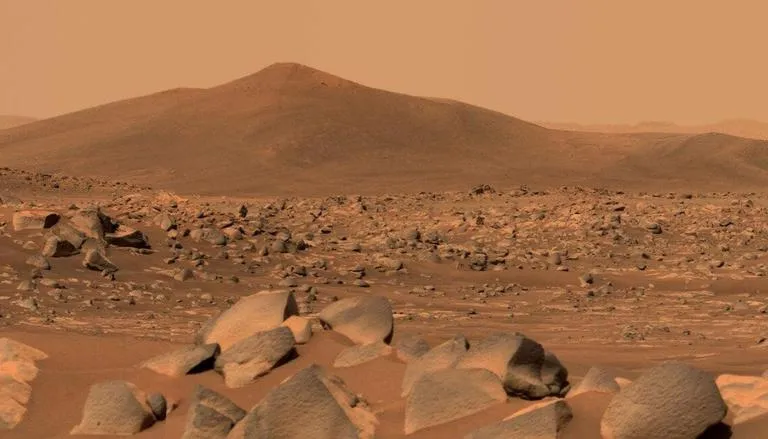Curtin University is researching a chunk of a Martian meteorite found on Earth in the Moroccan Sahara Desert in 2011 and initially reported in 2013.
According to experts from Australia’s Curtin University, scientists are one step closer to knowing when Mars was habitable, who claim to have discovered evidence for the same.
The specialists were looking at a fragment of a Martian meteorite found on Earth in the Moroccan Sahara Desert in 2011 and was initially reported in 2013.
According to the scientists ‘ research published in the journal Science Advances, the rock from Mars, known as NWA 7034 or ‘black beauty,’ weighs 320 grams and contains information on the red planet’s early existence.

(NWA 7034, often known as the “black beauty”; NASA image)
‘It’s a One-Time Gift From Mars’
According to the primary author Morgan Cox, this rock, from a collection of fragmented rock shards and minerals, predominantly basalt, is a treasure trove of information on the damage caused by meteorite strikes on Mars.
This grain is undoubtedly a one-of-a-kind gift from Mars. High-pressure shock deformation has never been seen in any Black Beauty minerals before.
The finding of shock damage in a 4.45 billion-year-old Martian zircon adds to our understanding of the dynamic processes that influenced the surface of early Mars, as Cox said in a Curtin University paper.
The ‘shock deformation’ that Cox refers to is the slight damage induced in the rock by the shock waves released after an impact.
The rock analyzed in this research was found to have traces of the mineral zircon, which crystallizes from magma and is thought to be a “geochronometer,” which records how much time has passed.
Experts say’shocked’ zircons can only be discovered on Earth in impact craters like Vredefort in South Africa, Sudbury in Canada, and Chicxulub in Mexico.
The final one is where the dinosaur-killing event occurred, resulting in mass extinction.
In a paper, co-author Dr. Aaron Cavosie said that prior zircon studies in Martian meteorites suggested that circumstances appropriate for life may have existed by 4.2 billion years ago based on the lack of substantial shock damage.
Another reason why these discoveries are significant is that scientists believe Mars must have been habitable considerably later than previously thought.
The habitability window must have coincided with water on Mars by 3.9 to 3.7 billion years ago.
Follow-up research remains to identify when and where life existed on Mars in the past.
The Meteorite was Smashed by Humans
In 2011, the original 319.8 gram heavy meteorite Black Beauty was discovered in the Sahara Desert.
The meteorite quickly became evident to be something extraordinary, and it now sells for about $10,000 per gram.
Professor Martin Bizzarro was able to purchase 44 grams of Black Beauty a year ago with the support of several financing sources and the exchange of meteorites from the museum’s collection.
“One of the big challenges has been that the zircons in Black Beauty are extremely small. This called for a courageous strategy: We crushed our precious meteorite. Or to be precise: We crushed 5 grams. Today, I’m glad we chose that strategy. It released seven zircons, one of which is the oldest known zircon from Mars. And from the zircons and their content of hafnium, we can now conclude that the crystallization of the surface of Mars went extremely fast: already 20 million years after the formation of the solar system, Mars had a solid crust that could potentially could house oceans and perhaps also life.”
He added that Zircon is an extremely hard mineral that is perfect for providing exact ages.
In this context, zircons may be utilized to provide a chronological framework for understanding the history of the Martian crust’s creation.
Zircon also functions as a little time capsule, preserving information about the environment in which it was formed and when it was formed.
In this example, a time capsule containing hafnium from Mars’s earliest crust, which existed around 100 million years before the oldest zircon of Black Beauty was formed.
As a result, Mars gained a head start on Earth, whose solid crust didn’t emerge until much later.
To achieve this goal, though, a certain level of bravery was necessary.












Leave a Reply